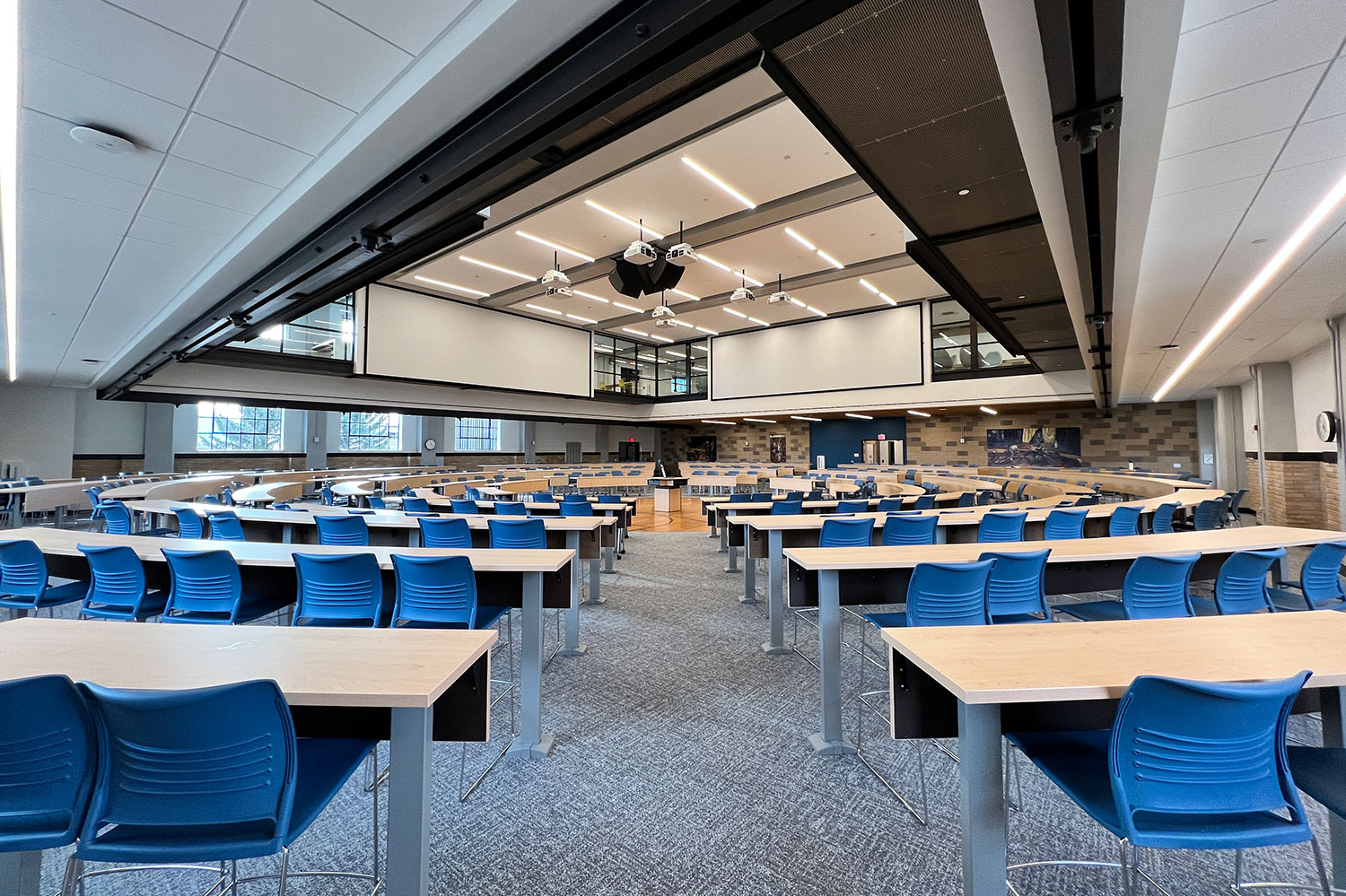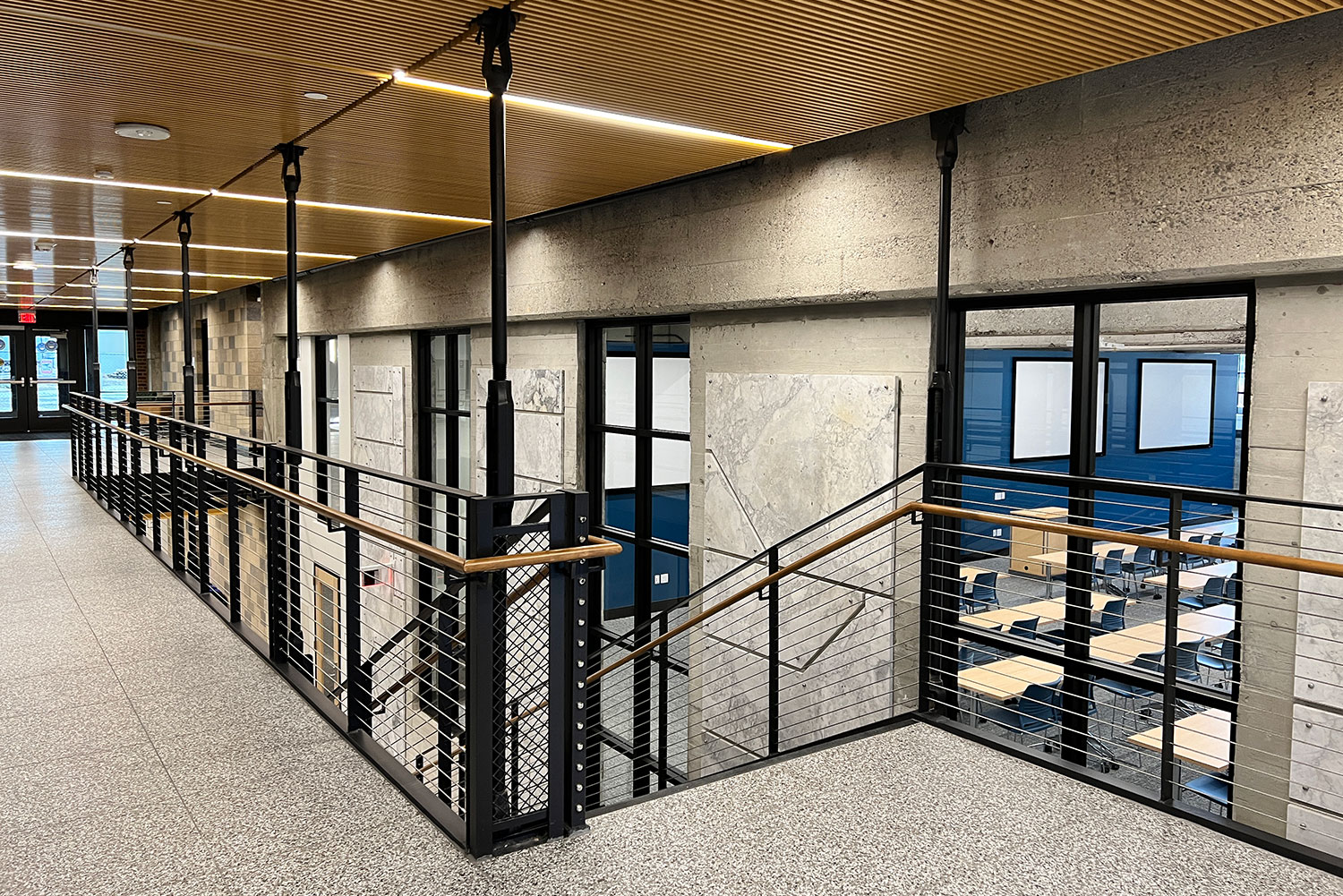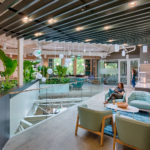Montana State University’s Beloved, Historic Romney Hall Awarded LEED Gold
Celebrating a sustainability milestone inspired by generations of forward-thinking students.

Originally constructed in 1922, Romney Hall is one of the most noteworthy buildings on Montana State University’s (MSU) campus in Bozeman. Prominently located along Grant Street and adjacent to the open greenspace of the Romney Oval, this iconic building contributes significant value to the MSU Historic District, and is listed on the National Register of Historic Places.
Built in the Italian Renaissance Revival style, the building has a beautifully detailed tapestry brick façade featuring unique terra cotta spandrels decorated with sporting equipment, large wood and steel windows, copper detailing, and a barrel-vaulted metal roof.
The renovation and repurposing of Romney Hall endeavored to maintain the historic integrity of the building while providing much-needed upgrades to accommodate expanding student services and educational needs. The project transformed a nonfunctional gymnasium into much-needed instructional space, as well as added 17 classrooms and centers for mathematics, writing, veterans, and students with disabilities.
Additionally, in alignment with the university’s sustainability commitments and the State of Montana’s High-Performance Building Standards, modernizing the historic building to meet 21st century student needs included meeting the sustainability standards of the Leadership in Energy and Environmental Design (LEED) green building certification program.
Romney has been an incredible sustainability success in that we were able to reuse a 100-year-old building, transforming an iconic and historical structure into a premier teaching facility to serve students for decades to come.
John How, Associate Vice President, MSU University Services
On its own, preservation and reuse of an existing historic building is an inherently sustainable strategy due to the utilization of existing material resources and their embodied carbon footprint, combined with the reduction of energy and waste associated with demolition and construction. In fact, according to a study by the National Trust for Historic Preservation, “For those concerned with climate change and other environmental impacts, reusing an existing building and upgrading it to maximum efficiency is almost always the best option regardless of building type and climate.”
The LEED Gold certification of Romney Hall demonstrates how historic building preservation combined with high-performance building upgrades, results in a healthy, resource-efficient environment for building occupants. And for MSU, ultimately, extends the lifespan of beloved campus treasure for future generations.
Sustainable Design Achievement
While there’s much to celebrate about Romney Hall, here are some of its most notable sustainability achievements:
LEED Gold Certification. Awarded LEED Gold certification under the Building Design and Construction (BD+C) Rating System (a hybrid of LEED 2009 & LEED v4/v4.1 for Materials and Resources).
Campus-wide Commitment. The ninth LEED-certified building on the MSU campus, Romney Hall further contributes to the university’s commitment to sustainability. MSU’s campus-wide sustainability commitments offered significant contributions to Romney’s final LEED award through programs and amenities such as waste diversion, green building education, the promotion of sustainable transportation systems, and ecologically responsible campus grounds.
Building and Material Reuse. Thoughtful design decisions allowed for a total of 54.89% of the existing Romney Hall building resources to be preserved and reused, including structural elements, enclosure materials, and permanently installed interior elements.
Energy Performance Optimizations. Guided by computer-based energy modeling simulations, the renovation of Romney Hall improved the building’s energy performance by 40.9%, compared to a building designed to meet minimum code requirements. This significant achievement was made possible, in part, by the integration of SolarWall technology — a solar air heating system that uses solar energy to pre-treat the building ventilation air to reduce energy consumption and heating costs.
Commissioning. To verify that the project’s energy-related systems are installed, calibrated, and perform according to MSU’s high-performance building standards, the mechanical, electrical, hot water, and geothermal renewable energy systems underwent a systematic quality-focused commissioning process.
Green Power. MSU is engaged in a two-year renewable energy contract to provide 35% of Romney’s electricity from renewable sources, as defined by the Center for Resource Solutions’ Green-e Energy product certification requirements.
Water Use Reduction. Through the installation of water-efficient fixtures, Romney Hall is expected to achieve a 33% indoor water use reduction compared to a baseline building designed without water efficient fixtures.
Outdoor Air Delivery Monitoring. Permanent carbon dioxide (CO2) monitoring systems were installed to track CO2 levels while allowing the MSU facilities teams to ensure adequate outdoor air ventilation rates are maintained.
Acoustic Performance. To promote acoustic comfort and provide learning environments that facilitate effective communications and occupant well-being, the design includes features to limit background noise and the transmission of noise between spaces.
Controllable Lighting Systems. Throughout the building, newly installed controls provide a high level of lighting system control for individual and multi-occupant spaces, promoting productivity, comfort, and well-being.
Low-Emitting Materials. To promote the health of building occupants and prevent harmful and irritating indoor air contaminants, the following measures were achieved:
- 100% of paints, coatings, adhesives, and sealants used on the interior of the building met the standards for low-emitting materials.
- 100% of installed flooring system products met the testing and product requirements for low-emitting flooring materials.
- 100% of composite wood/agrifiber products used on the interior of the building do not contain added urea-formaldehyde resins.
Recycled Content. More than 26% of the total materials budget was invested in products with environmentally and socially preferable lifecycle impacts, including sustainable forestry practices, products containing pre and post-consumer recycled content, and products purchased from manufacturers that participate in take-back recycling programs that minimize material waste.
Environmental Product Declarations. A total of 42 products with Environmental Product Declarations were installed. This earned Romney Hall an exemplary performance status for the sourcing of products and materials from manufacturers who have verified improved environmental lifecycle impacts of their products.
Material Ingredients. A total of 38 products with transparent disclosure of material ingredients were installed. This achievement exceeded the baseline requirement of 20 products and helps promote products and materials that evaluate and disclose human and environmental health impacts.
Construction Indoor Air Quality Management Plan. During construction, an indoor air quality management plan was enforced to protect HVAC equipment, absorptive materials, and prioritize regular maintenance of the building to reduce indoor air contaminants.
Construction Waste Management. Throughout construction, a total of 2,319 tons or 78.28% of all construction waste, was recycled and/or reused and ultimately, diverted from the landfill.

This rendering illustrates the addition to the southside of Romney Hall, which has a glass enclosure on the exterior to accommodate a staircase and provide additional circulation. It also features the SolarWall technology — an air heating system that uses solar energy to pre-treat the building ventilation air to reduce energy consumption and heating costs.
An Example of More to Come
In addition to the extensive sustainable design characteristics, Romney also shines as an example of careful and thoughtful historic preservation. Just this week, Romney Hall was recognized as the winner of the City of Bozeman Historic Preservation Advisory Board’s Historic Preservation Awards in the Adaptive Reuse category.
This project has great potential to serve as an example not only for other higher education facilities across the country, but also for the possibilities that exist when preservation is prioritized. I look forward to more well-deserved recognition for this truly impressive project and the incredibly talented team members and partners who made it all possible.
Read more about the project in the MSU press release.







